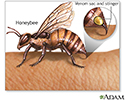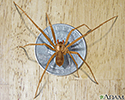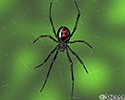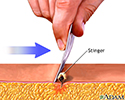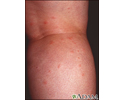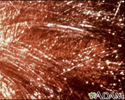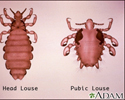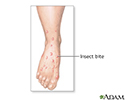Insect bites and stings
Bee sting; Bites - insects, bees, and spiders; Black widow spider bite; Brown recluse bite; Flea bite; Honey bee or hornet sting; Lice bites; Mite bite; Scorpion bite; Spider bite; Wasp sting; Yellow jacket sting
Insect bites and stings can cause an immediate skin reaction. The bite from fire ants and the sting from bees, wasps, and hornets are most often painful. Bites caused by mosquitoes, fleas, and mites are more likely to cause itching than pain.
Insect and spider bites cause more deaths from venom reactions than bites from snakes.
Considerations
In most cases, bites and stings can be easily treated at home.
Some people have extreme reactions that require immediate medical treatment to prevent death.
Certain spider bites, such as the black widow or brown recluse, can cause serious illness or death. Most spider bites are harmless. If possible, bring the insect or spider that bit you with you when you go for medical treatment so it can be identified.
Black widow
The black widow spider has a shiny black body with a red hourglass-shape on its belly area. The bite of a black widow spider is poisonous. This arti...

Symptoms
Symptoms depend on the type of bite or sting. They may include:
- Pain
- Redness
- Swelling
- Itching
- Burning
- Numbness
- Tingling
Some people have severe, life-threatening reactions to bee stings or insect bites. This is called anaphylactic shock. This condition can occur very quickly and lead to rapid death if not treated quickly.
Symptoms of anaphylaxis can occur quickly and affect the whole body. They include:
- Chest pain
- Face or mouth swelling
- Difficulty swallowing
- Difficulty breathing
- Fainting or lightheadedness
- Abdominal pain or vomiting
- Rash or flushing
First Aid
For severe reactions, first check the person's airways and breathing. If necessary, call 911 and begin rescue breathing and CPR . Then, follow these steps:
CPR
CPR stands for cardiopulmonary resuscitation. It is an emergency lifesaving procedure that is done when someone's breathing or heartbeat has stopped...
- Reassure the person. Try to keep him or her calm.
- Remove nearby rings and constricting items because the affected area may swell.
- Use the person's EpiPen or other emergency kit, if they have one. (Some people who have serious insect reactions carry it with them.)
-
If appropriate, treat the person for signs of
shock
. Remain with the person until medical help arrives.
Shock
Shock is a life-threatening condition that occurs when the body is not getting enough blood flow. Lack of blood flow means that the cells and organs...
 ImageRead Article Now Book Mark Article
ImageRead Article Now Book Mark Article
General steps for most bites and stings:
Remove the stinger by scraping the back of a credit card or other straight-edged object across the stinger. Do not use tweezers -- these may squeeze the venom sac and increase the amount of venom released.
Wash the site thoroughly with soap and water. Then, follow these steps:
- Place ice (wrapped in a washcloth) on the site of the sting for 10 minutes and then off for 10 minutes. Repeat this process.
- If necessary, take an antihistamine, or apply creams that reduce itching.
- Over the next several days, watch for signs of infection (such as increasing redness, swelling, or pain).
Do Not
Use the following precautions:
- Do NOT apply a tourniquet.
-
Do NOT give the person stimulants, aspirin, or other
pain medicine
unless prescribed by the doctor.
Pain medicine
Over-the-counter (OTC) pain relievers can help relieve pain or lower a fever. Over-the-counter means you can buy these medicines without a prescript...
 ImageRead Article Now Book Mark Article
ImageRead Article Now Book Mark Article
When to Contact a Medical Professional
Call 911 or your local emergency number if someone with a sting has the following symptoms:
- Trouble breathing, wheezing, shortness of breath
- Swelling anywhere on the face or in the mouth
- Throat tightness or difficulty swallowing
- Feeling weak
- Turning blue
If you had a severe, bodywide reaction to a bee sting, your health care provider should send you to an allergist for skin testing and therapy. You should receive an emergency kit to carry with you wherever you go.
Prevention
You can help prevent insect bites and stings by doing the following:
- Avoid rapid, jerky movements around insect hives or nests.
- Avoid perfumes and floral-patterned or dark clothing.
- Use appropriate insect repellents and protective clothing.
- Use caution when eating outdoors, especially with sweetened beverages or in areas around garbage cans, which often attract bees.
- If you have severe allergies to insect bites or stings, you should have an emergency kit and an EpiPen. Make sure your friends and family know how to use it if you have a reaction.
References
Elston DM. Arthropods and leeches. In: Goldman L, Schafer AI, eds. Goldman's Cecil Medicine . 25th ed. Philadelphia, PA: Elsevier Saunders; 2016:chap 359.
Fradin MS, Carroll SP. Protection from blood-feeding arthropods. In: Auerbach PS, ed. Wilderness Medicine . 6th ed. Philadelphia, PA: Elsevier Saunders; 2012:chap 47.
Otten EJ. Venomous animal injuries. In: Marx JA, Hockberger RS, Walls RM, et al, eds. Rosen's Emergency Medicine: Concepts and Clinical Practice . 8th ed. Philadelphia, PA: Elsevier Saunders; 2014:chap 62.
-
Bedbug - close-up - illustration
Bed bugs bites can leave a colorless welt along with an itching or burning sensation. (Image courtesy of the Centers for Disease Control and Prevention.)
Bedbug - close-up
illustration
-
Black widow spider - illustration
This is a black widow spider. Note the red "hour glass" on the abdomen. The bite of the black widow can produce severe symptoms but is seldom fatal, except in young children and older adults. (Image courtesy of the Centers for Disease Control and Prevention.)
Black widow spider
illustration
-
Body louse - illustration
This is a magnified view of a body louse. Lice produce itching and a characteristic skin rash, which looks like a scrape. Lice may also carry organisms that cause relapsing fever, typhus, and trench fever. (Image courtesy of the Centers for Disease Control and Prevention.)
Body louse
illustration
-
Flea - illustration
Different types of fleas prefer specific animals as hosts, but will infest humans if their specific hosts are unavailable. Fleas can carry plague and typhus. They are also thought to transmit several other diseases. (Image courtesy of the Centers for Disease Control and Prevention.)
Flea
illustration
-
Fly - illustration
Flies carry disease by transporting infectious agents on their feet. They may spread salmonellosis, typhoid, and other diseases. (Image courtesy of the Centers for Disease Control and Prevention.)
Fly
illustration
-
Kissing bug - illustration
Triatomid, the kissing bug, can carry Chagas' disease (American trypanosomiasis). (Image courtesy of the Centers for Disease Control and Prevention.)
Kissing bug
illustration
-
Dust mite - illustration
This is a magnified photograph of a dust mite. Mites are carriers (vectors) of many important diseases including typhus (scrub and murine) and rickettsialpox. (Image courtesy of the Centers for Disease Control and Prevention.)
Dust mite
illustration
-
Mosquito, adult feeding on the skin - illustration
There are many different species of mosquito, which can carry some of the world's most common and significant infectious diseases, including West Nile, Malaria, yellow fever, viral encephalitis, and dengue fever. (Image courtesy of the Centers for Disease Control and Prevention.)
Mosquito, adult feeding on the skin
illustration
-
Wasp - illustration
Wasps are not known to carry human diseases, but allergic reactions to their sting can be fatal. (Image courtesy of the Centers for Disease Control and Prevention.)
Wasp
illustration
-
Insect stings and allergy - illustration
Allergic reaction to bee stings occurs when a person becomes sensitized to the venom from a previous sting. This reaction is different from the reaction to the poison in the bite of a black widow spider, which injects a potent toxin into the blood. Ordinarily, bee venom is not toxic and will only cause local pain and swelling. The allergic reaction comes when the immune system is oversensitized to the venom and produces antibodies to it. Histamines and other substances are released into the bloodstream, causing blood vessels to dilate and tissues to swell. Severe reactions can lead to anaphylactic shock, a life-threatening series of symptoms including swelling of the throat and difficulty breathing. Persons who develop an allergy to bee stings should carry prescription bee sting kits to counteract the reaction to bee venom.
Insect stings and allergy
illustration
-
Brown recluse spider - illustration
The brown recluse is a venomous spider most commonly found in midwestern and southern states of the United States. It is about one-half inch overall and has long skinny legs. The brown recluse is brown with a characteristic dark violin-shaped marking on its head. It is most commonly found outside in wood, leaves, or in piles of rocks. If a brown recluse wanders indoors they will go to dark closets, shoes, or attics. The brown recluse is a non-aggressive spider and will only bite when it is disturbed.
Brown recluse spider
illustration
-
Black widow spider - illustration
The female black widow is easily recognized by her shiny black body and red hourglass marking underneath her round abdomen. Although black widows can be found in nearly every state they are most common in the southern areas of the United States. The black widow makes her home in wood piles, under eaves, and other undisturbed places. The bite of a black widow can be serious and require medical attention. Symptoms include pain radiating from the site of the bite, nausea, overall aching of the body, profuse sweating, and labored breathing.
Black widow spider
illustration
-
Stinger removal - illustration
To remove a stinger, scrape the back of a knife or other straight-edged object across the stinger. Do not use tweezers since it may squeeze the venom sac and increase the amount of venom released into the wound. Next wash the site thoroughly with soap and water. Place ice wrapped in a washcloth or other suitable covering on the site of the sting for 10 minutes and then off for 10 minutes. If needed an antihistamine can be applied to help reduce the itching. Over the next several days the stinger site should be watched for signs of infection, such as increased redness, swelling, or pain.
Stinger removal
illustration
-
Flea bite - close-up - illustration
Fleas are blood-feeding insects. Pain and itching results from an allergic reaction to the materials that the fleas inject into the skin at the time of the bite.
Flea bite - close-up
illustration
-
Insect bite reaction - close-up - illustration
This is a 2 to 3 centimeter wide blood-filled (hemorrhagic) blister (bullae) that has resulted from an insect bite. It is located on the wrist. Bullae formation and tissue necrosis (death) are more common with spider bites, but may also be caused by insect bites.
Insect bite reaction - close-up
illustration
-
Insect bites on the legs - illustration
Insect bites may be grouped, raised (papular), hive-like (urticarial) and have a surrounding halo. Occasionally a central depression, or punctum, can be seen.
Insect bites on the legs
illustration
-
Head louse, male - illustration
Pediculus humanus var. capitis
Head louse, male
illustration
-
Head louse - female - illustration
Pediculus humanus var. capitis
Head louse - female
illustration
-
Head louse infestation - scalp - illustration
This is a close-up picture of lice egg sacks (nits) on the hair. They cling to individual hair shafts. (Image courtesy of the Centers for Disease Control and Prevention.)
Head louse infestation - scalp
illustration
-
Lice, body with stool (Pediculus humanus) - illustration
These are Pediculus humanus, or body lice. Other types of lice infest the scalp, head (Pediculus humanus capitis), or the pubic area (Phthirus pubis). Some body lice may carry diseases such as epidemic typhus, relapsing fever, or trench fever. (Image courtesy of the Centers for Disease Control and Prevention.) Pediculus humanus Pediculus humanus capitis Phthirus pubis
Lice, body with stool (Pediculus humanus)
illustration
-
Body louse, female and larvae - illustration
This is a magnified view of a female body louse with larvae. Lice cause itching and a characteristic excoriated skin rash (looks like a scrape). They may also transmit diseases, including relapsing fever, typhus, and trench fever. (Image courtesy of the Centers for Disease Control and Prevention.)
Body louse, female and larvae
illustration
-
Crab louse, female - illustration
This is a photomicrograph of a female pubic louse. The condition known as "crabs" is so named because of the resemblance of a pubic louse to a crab. The bodies of pubic lice are shorter and rounder than those of head lice. (Image courtesy of the Centers for Disease Control and Prevention.)
Crab louse, female
illustration
-
Pubic louse-male - illustration
This is a photomicrograph of a male pubic louse. The condition known as "crabs" is so named because of the resemblance of a pubic louse to a crab. The bodies of pubic lice are shorter and rounder than those of head lice.
Pubic louse-male
illustration
-
Head louse and pubic louse - illustration
This picture compares the relative size and shape of the head louse and the pubic louse.
Head louse and pubic louse
illustration
-
Brown recluse spider bite on the hand - illustration
This lesion was produced by the bite of a brown recluse spider. The brown recluse is one of two common spiders in the United States considered venomous. (The other is the black widow.) However, the hobo spider, wolf spider, and jumping spider can also produce bites that require medical attention.
Brown recluse spider bite on the hand
illustration
-
Insect bites and stings - illustration
Even though some insect bites or stings can be extremely painful they usually do not require emergency medical care. Although the stung or bitten area should be carefully observed for signs of infection or reaction to venom.
Insect bites and stings
illustration
-
Bedbug - close-up - illustration
Bed bugs bites can leave a colorless welt along with an itching or burning sensation. (Image courtesy of the Centers for Disease Control and Prevention.)
Bedbug - close-up
illustration
-
Black widow spider - illustration
This is a black widow spider. Note the red "hour glass" on the abdomen. The bite of the black widow can produce severe symptoms but is seldom fatal, except in young children and older adults. (Image courtesy of the Centers for Disease Control and Prevention.)
Black widow spider
illustration
-
Body louse - illustration
This is a magnified view of a body louse. Lice produce itching and a characteristic skin rash, which looks like a scrape. Lice may also carry organisms that cause relapsing fever, typhus, and trench fever. (Image courtesy of the Centers for Disease Control and Prevention.)
Body louse
illustration
-
Flea - illustration
Different types of fleas prefer specific animals as hosts, but will infest humans if their specific hosts are unavailable. Fleas can carry plague and typhus. They are also thought to transmit several other diseases. (Image courtesy of the Centers for Disease Control and Prevention.)
Flea
illustration
-
Fly - illustration
Flies carry disease by transporting infectious agents on their feet. They may spread salmonellosis, typhoid, and other diseases. (Image courtesy of the Centers for Disease Control and Prevention.)
Fly
illustration
-
Kissing bug - illustration
Triatomid, the kissing bug, can carry Chagas' disease (American trypanosomiasis). (Image courtesy of the Centers for Disease Control and Prevention.)
Kissing bug
illustration
-
Dust mite - illustration
This is a magnified photograph of a dust mite. Mites are carriers (vectors) of many important diseases including typhus (scrub and murine) and rickettsialpox. (Image courtesy of the Centers for Disease Control and Prevention.)
Dust mite
illustration
-
Mosquito, adult feeding on the skin - illustration
There are many different species of mosquito, which can carry some of the world's most common and significant infectious diseases, including West Nile, Malaria, yellow fever, viral encephalitis, and dengue fever. (Image courtesy of the Centers for Disease Control and Prevention.)
Mosquito, adult feeding on the skin
illustration
-
Wasp - illustration
Wasps are not known to carry human diseases, but allergic reactions to their sting can be fatal. (Image courtesy of the Centers for Disease Control and Prevention.)
Wasp
illustration
-
Insect stings and allergy - illustration
Allergic reaction to bee stings occurs when a person becomes sensitized to the venom from a previous sting. This reaction is different from the reaction to the poison in the bite of a black widow spider, which injects a potent toxin into the blood. Ordinarily, bee venom is not toxic and will only cause local pain and swelling. The allergic reaction comes when the immune system is oversensitized to the venom and produces antibodies to it. Histamines and other substances are released into the bloodstream, causing blood vessels to dilate and tissues to swell. Severe reactions can lead to anaphylactic shock, a life-threatening series of symptoms including swelling of the throat and difficulty breathing. Persons who develop an allergy to bee stings should carry prescription bee sting kits to counteract the reaction to bee venom.
Insect stings and allergy
illustration
-
Brown recluse spider - illustration
The brown recluse is a venomous spider most commonly found in midwestern and southern states of the United States. It is about one-half inch overall and has long skinny legs. The brown recluse is brown with a characteristic dark violin-shaped marking on its head. It is most commonly found outside in wood, leaves, or in piles of rocks. If a brown recluse wanders indoors they will go to dark closets, shoes, or attics. The brown recluse is a non-aggressive spider and will only bite when it is disturbed.
Brown recluse spider
illustration
-
Black widow spider - illustration
The female black widow is easily recognized by her shiny black body and red hourglass marking underneath her round abdomen. Although black widows can be found in nearly every state they are most common in the southern areas of the United States. The black widow makes her home in wood piles, under eaves, and other undisturbed places. The bite of a black widow can be serious and require medical attention. Symptoms include pain radiating from the site of the bite, nausea, overall aching of the body, profuse sweating, and labored breathing.
Black widow spider
illustration
-
Stinger removal - illustration
To remove a stinger, scrape the back of a knife or other straight-edged object across the stinger. Do not use tweezers since it may squeeze the venom sac and increase the amount of venom released into the wound. Next wash the site thoroughly with soap and water. Place ice wrapped in a washcloth or other suitable covering on the site of the sting for 10 minutes and then off for 10 minutes. If needed an antihistamine can be applied to help reduce the itching. Over the next several days the stinger site should be watched for signs of infection, such as increased redness, swelling, or pain.
Stinger removal
illustration
-
Flea bite - close-up - illustration
Fleas are blood-feeding insects. Pain and itching results from an allergic reaction to the materials that the fleas inject into the skin at the time of the bite.
Flea bite - close-up
illustration
-
Insect bite reaction - close-up - illustration
This is a 2 to 3 centimeter wide blood-filled (hemorrhagic) blister (bullae) that has resulted from an insect bite. It is located on the wrist. Bullae formation and tissue necrosis (death) are more common with spider bites, but may also be caused by insect bites.
Insect bite reaction - close-up
illustration
-
Insect bites on the legs - illustration
Insect bites may be grouped, raised (papular), hive-like (urticarial) and have a surrounding halo. Occasionally a central depression, or punctum, can be seen.
Insect bites on the legs
illustration
-
Head louse, male - illustration
Pediculus humanus var. capitis
Head louse, male
illustration
-
Head louse - female - illustration
Pediculus humanus var. capitis
Head louse - female
illustration
-
Head louse infestation - scalp - illustration
This is a close-up picture of lice egg sacks (nits) on the hair. They cling to individual hair shafts. (Image courtesy of the Centers for Disease Control and Prevention.)
Head louse infestation - scalp
illustration
-
Lice, body with stool (Pediculus humanus) - illustration
These are Pediculus humanus, or body lice. Other types of lice infest the scalp, head (Pediculus humanus capitis), or the pubic area (Phthirus pubis). Some body lice may carry diseases such as epidemic typhus, relapsing fever, or trench fever. (Image courtesy of the Centers for Disease Control and Prevention.) Pediculus humanus Pediculus humanus capitis Phthirus pubis
Lice, body with stool (Pediculus humanus)
illustration
-
Body louse, female and larvae - illustration
This is a magnified view of a female body louse with larvae. Lice cause itching and a characteristic excoriated skin rash (looks like a scrape). They may also transmit diseases, including relapsing fever, typhus, and trench fever. (Image courtesy of the Centers for Disease Control and Prevention.)
Body louse, female and larvae
illustration
-
Crab louse, female - illustration
This is a photomicrograph of a female pubic louse. The condition known as "crabs" is so named because of the resemblance of a pubic louse to a crab. The bodies of pubic lice are shorter and rounder than those of head lice. (Image courtesy of the Centers for Disease Control and Prevention.)
Crab louse, female
illustration
-
Pubic louse-male - illustration
This is a photomicrograph of a male pubic louse. The condition known as "crabs" is so named because of the resemblance of a pubic louse to a crab. The bodies of pubic lice are shorter and rounder than those of head lice.
Pubic louse-male
illustration
-
Head louse and pubic louse - illustration
This picture compares the relative size and shape of the head louse and the pubic louse.
Head louse and pubic louse
illustration
-
Brown recluse spider bite on the hand - illustration
This lesion was produced by the bite of a brown recluse spider. The brown recluse is one of two common spiders in the United States considered venomous. (The other is the black widow.) However, the hobo spider, wolf spider, and jumping spider can also produce bites that require medical attention.
Brown recluse spider bite on the hand
illustration
-
Insect bites and stings - illustration
Even though some insect bites or stings can be extremely painful they usually do not require emergency medical care. Although the stung or bitten area should be carefully observed for signs of infection or reaction to venom.
Insect bites and stings
illustration
-
Insect bites and stings
(Alt. Medicine)
Review Date: 11/4/2015
Reviewed By: Jesse Borke, MD, FACEP, FAAEM, Attending Physician at FDR Medical Services/Millard Fillmore Suburban Hospital, Buffalo, NY. Also reviewed by David Zieve, MD, MHA, Isla Ogilvie, PhD, and the A.D.A.M. Editorial team.










